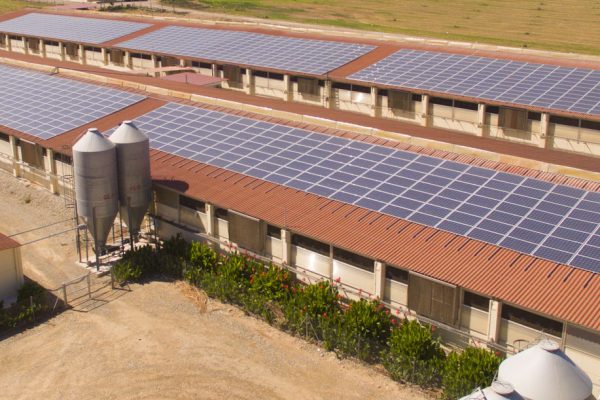Using photovoltaic panels in agriculture can be very advantageous. The reason why it is so advantageous is that you can produce electricity from a renewable and clean source of energy using the sunlight, which is a free and inexhaustible soruce. Those who work in the agricultural industry know really well how much energy is needed for the various production processes. Thanks to this technology, agriculture can become energy independent from the national electricity distribution grid and the energy in excess can be sold to electricity distribution companies.

In this regard, installing photovoltaic panels on agricultural land used for crops and for producing electricity, could be seen as an interesting opportunity to diversify agricultural revenues, reducing energy costs, the emissions of pollutants and maintenance intervention compared to traditional systems. This can also contribute to the achievement of the EU policy goals regarding the environment and the climate.
Photovoltaic panels, a versatile technology for the agricultural industry
The Italian agriculture industry and the technology behind photovoltaic panels are strictly connected. We are dealing with a profitable eco-sustainable relationship, that allows reducing costs and saving energy, even for more than 20 years.
Regarding photovoltaics, the renewable RES decree of the Ministry of Economic Development, which is expected to be approved at the end of the summer, provides new incentives starting from 2018 until 2020, for the most competitive renewable kinds of energy. This means that these incentives are addressed to those factories that produce electricity with renewable sources and that stand out for the quality of their projects, the protection of the environment, of the climate, the landscape and the territory.
- More specifically, photovoltaic panels can be used both for crops and for producing electricity using solar radiation as a renewable and clean energy source with a minimal environmental impact, as regards the emission of CO2 in the air, i.e. an abbreviation that indicates carbon dioxide. Carbon dioxide is one of the gases attributed to causing the greenhouse effect, i.e. the anomalous overheating of the world earth’s surface that causes dangerous melting of the glaciers and consequent flooding of the continents, intense climatic variations with torrential rains or an increase in desert areas…
- Another positive feature, that sometimes, is not even taken into consideration, is the reduced release of heavy metals into the soil and groundwater circulating underground. In fact, it should be remembered that photovoltaic systems provide better environmental performance than conventional energy solutions. In this respect, it should be noted that the values of GHGs, i.e. greenhouse gases, and EPBT values, an acronym for Energy Pay Back Time, i.e. the time needed for photovoltaic cells to generate as much energy as the energy used to produce the plant, are lower than traditional energy sources.
- Let’s also take into consideration that the excess of the electricity produced, in this case, but it is also valid in general, can be reinjected into the main electricity grid and become a profit. Regarding the energy in excess, knowing that the kWh (kilowatt hour) is the unit of measurement of the energy of an appliance with a power of 1 kW (1,000 watts) switched on for one hour and that, one MWh equals to 1,000 kWh, it’s then possible to calculate the prices for selling electricity supplied by photovoltaic panels.
According to the renewable RES decree, soon to be approved, electricity should be remunerated by the Energy Services Manager (GSE) controlled by the Ministry of Economy and Finance at a price of 110 euros per MWh for photovoltaic systems, from a minimum of 20 up to a maximum of 100 kW. While, 90 euros per MWh, will cover photovoltaic systems from a minimum of 100 kW up to a maximum of 1 MW. So by doing some calculations on the production capacity of a photovoltaic panel system and knowing the personal needs, a plant can get an idea of the possible profit it would get in reselling the energy in excess.
- Moreover, photovoltaic panels represent a very versatile technology that can be integrated both on the coverings and / or on the buildings surfaces that are already there, such as photovoltaic tiles on roofs, and be installed directly on the ground, although such a choice could open further discussions on the lawfulness of using some land to plant photovoltaic panels. In this regard, and without going into more details here, it must also be said that the installation of photovoltaic systems must be carried out respecting the natural landscape and the agricultural activities, especially to protect the fertility of the productive land. Moreover, there are some limits imposed by the law on how much land can be subtracted from crops to build photovoltaic panels.
In this regard, it is equally important to point out that the subtraction of agricultural land is currently insignificant in Italy, although it is constantly and rapidly increasing. It should also be kept in mind that the taxation on photovoltaic panels applied to the agricultural industry is related to the power of the plants and to its connection with activities related to agriculture. More specifically, taxation can be calculated on the business income or on a cadastral basis according to the rules laid down by the Italian Revenue Agency.
As it has been seen in this article, agriculture can really get great benefits from the use of renewable energy. To know the full potential of the installation of photovoltaic panels used for agricultural crops and production activities, as well as to generate energy for resale, the Italian Farmers’ Confederation, one of the largest trade associations of farmers in Europe that aims to achieve environmentally sustainable agriculture for a better environmental protection, can provide more information and support about this matter.
